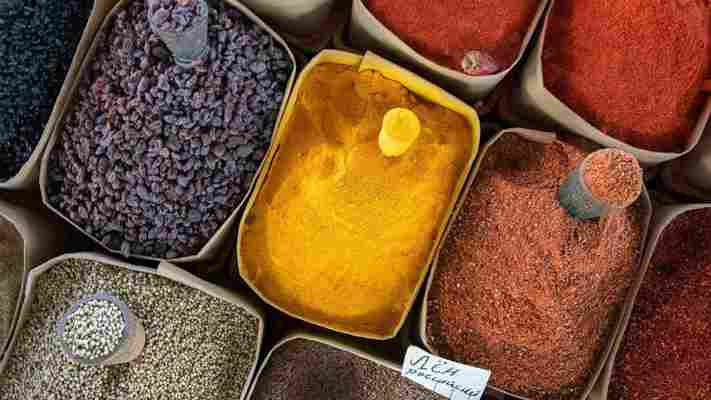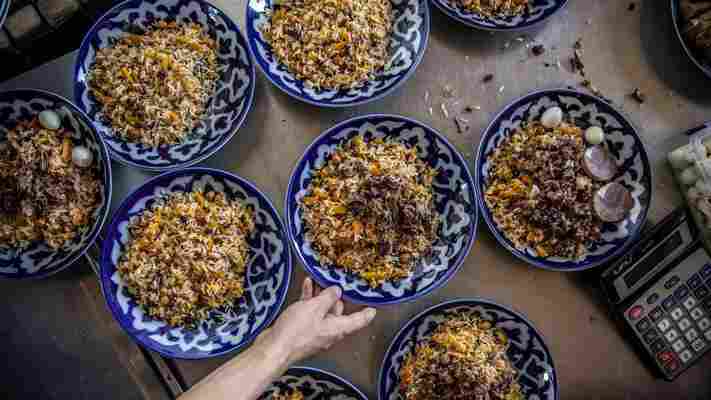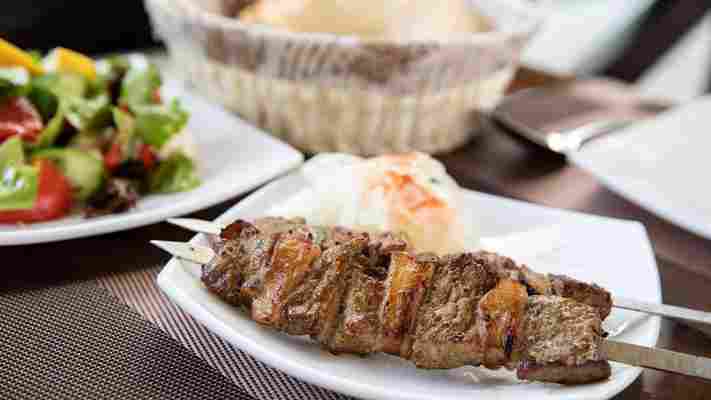

(Credit: Taylor Weidman)
(This year, we published many inspiring and amazing stories that made us fall in love with the world – and this is one our favourites. Click here for the full list).
Located along the former Silk Road, Uzbekistan has long benefitted from an exchange of goods and ideas with its neighbours. This exchange allowed its culture to bloom, as can be seen in the country’s stunning mosaics, crafts, artwork – and especially food.
Uzbek cuisine is hearty, rich and delicious. Developed to feed an agrarian society, many of its dishes are packed full of calories once needed to sustain workers in the fields. Recipes are heavy on meat, relying primarily on the fatty sheep that graze in the country’s pastureland. Other staple ingredients include flour, rice, vegetables and oil, as well as spices such as cumin, pepper, coriander, cinnamon and bay leaves.
With these ingredients, Uzbek cooks continue to whip up an impressive array of dishes, from delectable dumplings and soups to mouth-watering noodles and kebabs.

(Credit: Taylor Weidman)
Uzbek recipes vary from region to region, but the cuisine is unified by its “national dishes” that are commonly eaten and widely available throughout the country. The most popular and well known are:
Somsa : pastries typically filled with meat and onion and cooked in a tandyr (a clay oven).
Lagman : a rich, meat and noodle soup.
Naryn : a filling dish featuring hand-made noodles and meat.
Shurpa : a popular soup made with meat and vegetables.
Shashlik (kebab): grilled meats with spices.
Manti : steamed dumplings filled with meat and onions.
Non : traditional bread that is typically cooked in a tandyr.
Plov : a type of pilaf made with rice, carrots and meat.
(Credit: Taylor Weidman)
Uzbek cuisine is diverse and regional. There is so much to talk about and so much great food to share,” said Ravshan Khodjiev, a vlogger who specialises in Uzbek food.
(Credit: Taylor Weidman)
The region of Central Asia that makes up modern-day Uzbekistan has been populated for millennia and has a long, fascinating history. In 329BC, Alexander the Great conquered and then unified the area’s warring nomadic tribes, ushering in an age of stability that saw the region flourish as an important trading route between the East and West. Uzbekistan’s legendary Silk Road cities of Bukhara, Khiva and Samarkand emerged as key crossroads where merchants could buy and sell goods, as well as exchange ideas.
By the 8th Century, the region had converted to Islam, and elaborate madrassas and mosques paid for by mercantile wealth began to adorn the cities. Bukhara became known as an important centre for learning, with intellectuals from all across the Muslim world gathering to share ideas.
It is against this backdrop that Uzbekistan’s contemporary cuisine began forming. The cooking was influenced by traders and conquerors from all over the world, resulting in a unique fare. Even today, the influence of Turkic, Kazakh, Uyghur, Mongolian and many other cultures can be seen in Uzbekistan’s “national dishes”.
(Credit: Taylor Weidman)
Plov is the most popular and famous of all of Uzbekistan’s national dishes. According to one well-known story, the dish came into its own during the time of Amir Timur, the famous Uzbek conqueror who founded the Timurid Empire in the 1300s. According to legend, Timur needed a way to feed his huge armies during his conquests, and settled on plov as the ideal food, since it was high in calories and transportable.
After these wars, the dish’s simple yet delicious recipe may have spread with the returning soldiers. Many Uzbek cooks today still swear by the ratios rumoured to be used by Timur’s armies: one part each of meat, rice and carrots. The other heavily featured ingredient is a hefty portion of high-calorie oil. Some recipes (though not all) at the Central Asian Plov Centre in Tashkent even call for four types of oil – sesame, sunflower, linseed and cotton – in addition to animal fat in their plov. Regional varieties employ additional ingredients such as eggs, garlic, onions, tomatoes, peppers and spices.
Plov is eaten at nearly every special occasion in Uzbekistan, and many Uzbeks also eat it throughout the week – sometimes daily. The dish is similar to pilaf, a common Middle Eastern rice dish cooked in meat or vegetable stock, and is made in a traditional kazan (a deep cast-iron pot) over an open fire. It’s typically cooked by families, but during special occasions, an oshpaz (chef) prepares it, often serving several hundred guests from a single pot.
However, according to health experts, it’s possible to have too much of a good thing.
Plov is eaten at nearly every special occasion in Uzbekistan
Earlier this year, The Lancet released a global study researching diet-related deaths. The study found that in 2017 one in five deaths was caused by poor diet – primarily by consuming too much salt, too few whole grains and too few fruits and vegetables – and the country with the highest rate of diet-related deaths was Uzbekistan. This notion of having the world’s deadliest cuisine upset many Uzbeks, who are proud of their food and bemoan the timing of such a finding when the country is in the midst of establishing itself as an attractive tourism destination.
Lola Abdurakhimova, an Uzbek gastroenterologist, argues that the issue is not the food itself, but the changing lifestyle habits of Uzbek people. She explains that for an agrarian society working hard throughout the day, the Uzbek diet, if eaten in moderation, is appropriate.
The health issues, she says, arise due to three modern lifestyle changes: overeating, increasingly sedentary routines and a lack of dietary diversity. As Uzbeks have urbanised, they have become less active and are thus are burning fewer calories, but they are not changing their diet. Add to this the fact that socializing for Uzbeks usually involves food and can last for hours, and you have a recipe for overeating.
According to Abdurakhimova, the modern Uzbek diet is also lacking in fruits and vegetables. Formerly, these healthy foods would often be eaten as snacks, but today they are being replaced with foreign fast foods like hamburgers and doner , a type of kebab cooked on a rotisserie.
(Credit: Taylor Weidman)
The problem is our people don’t know when to stop. When the normal portion is four manti , some people eat eight or 10,” said Abdurakhimova.
(Credit: Taylor Weidman)
Uzbek food is well known and extremely popular throughout the Commonwealth of Independent States (CIS), a coalition of nine former Soviet republics. In most Central Asian cities, for example, it’s easy to find busy restaurants specializing in Uzbek cuisine.
The widespread popularity of Uzbek food is also represented online. Ravshan Khodjiev, who has been vlogging for three years about Uzbek food on his YouTube channel PROVEDU (in Russian), estimates that 60% of his tens of thousands of subscribers are non-Uzbek CIS members who follow him to learn more about how Uzbek food is made at the source. And that interest is only growing.
Outside the CIS, though, knowledge of the cuisine drops off precipitously. But the Uzbek government is trying to change that by raising the profile of Uzbekistan abroad.
(Credit: Taylor Weidman)
Recently, Uzbekistan has begun opening up to the outside world – slashing visa fees, training tourism workers and expanding international flight routes. As part of this push to develop its tourism sector, Uzbekistan’s State Committee for tourism development is seeking to use social media to attract visitors by inviting influencers from all over the world to see its sights and experience its local customs – and taste the food.
Last year, popular Thailand-based food vlogger Mark Wiens was invited to take a food tour of Uzbekistan, and his videos on the local cuisine were viewed more than 10 million times. This year, the committee invited nearly 100 influencers to tour the country. And, by all accounts, the reforms and charm offensive are working, as tourist numbers have more than tripled between 2014 and 2018.
(Credit: Taylor Weidman)
I experimented with everything except plov, which is what you may call ‘holy’. You shouldn’t spoil it. I tried once. Then I got an earful from everyone,” said Uzbek chef and restaurateur Bakhriddin Chustiy.
(Credit: Taylor Weidman)
Chefs are also eager to expose foreign audiences to Uzbek food. In 2010, Bakhriddin Chustiy became a sensation when, as a 26-year-old chef in Sochi, Russia, he got the opportunity to cook for former Russian president Dmitry Medvedev, who apparently said he loved the food.
When Chustiy returned to Uzbekistan, he opened his own restaurants where he aims to revolutionise Uzbek food by playing with new cooking techniques – while keeping the original flavours – and cutting down preparation times, tailoring tastes to different palates, and crucially, decreasing serving sizes. The only dish he says he is unable to change is plov (not pictured), a mistake he made once to the ire of local eaters.
Chustiy has also opened restaurants in Kazakhstan and Russia, with plans to expand further to continue to raise the profile of Uzbek food abroad. “When you come to London, you look at other restaurants with envy,” he said. “I hope that someday our cuisine will be as popular in huge cities.”
(Credit: Taylor Weidman)
With talented chefs, unique and tasty dishes, and a government eager to promote the country abroad, it appears that Uzbek food is primed to have an impact on the world’s culinary stage. And if it’s willing to adapt its traditional recipes to the changing lifestyles of locals and a foreign market that’s increasingly discerning when it comes to food health, it just might shed its “deadliest cuisine” moniker.
(Text, photos and video by Taylor Weidman ; additional reporting by Saidrasul Ashrafkhanov)
